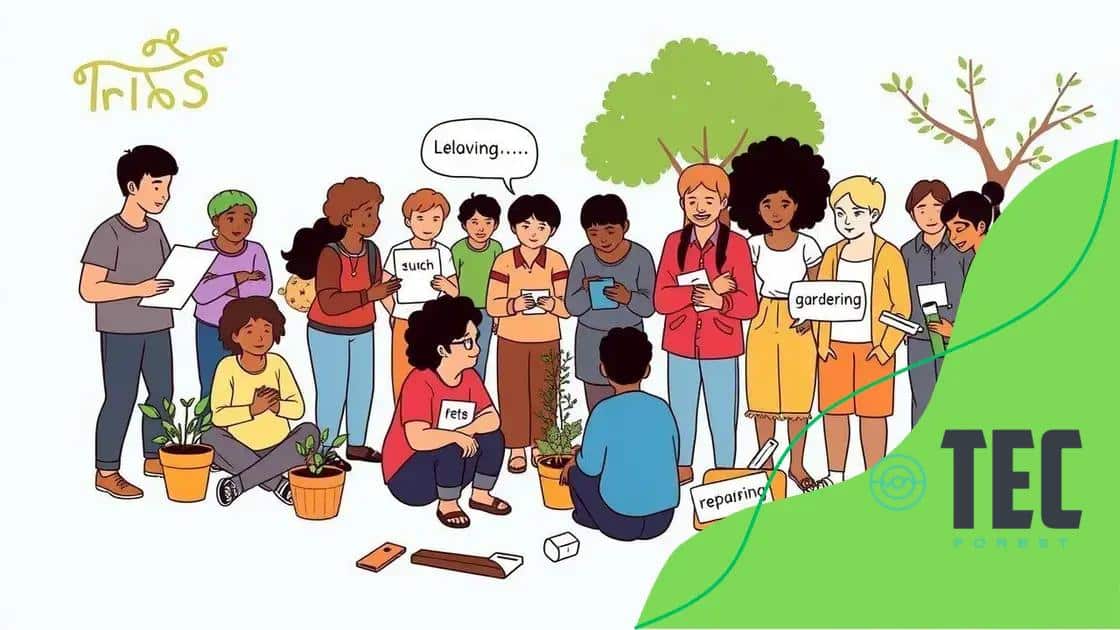Advertisement
Timebanking models serve as innovative community benefit systems by allowing individuals to exchange services based on time, fostering cooperation, support, and stronger social connections.
Timebanking models explored as alternative benefit systems offer innovative ways for communities to exchange services and support each other. Have you ever thought about how this approach could reshape social dynamics? Let’s dive into the details.
Advertisement
Understanding timebanking: a brief overview
Understanding timebanking requires a grasp of its underlying principles and community impact. Timebanking is a system where people exchange services based on time rather than money. This innovative approach strengthens community bonds and promotes collaboration. Imagine trading an hour of gardening for an hour of tutoring. It’s a win-win for everyone involved.
What is timebanking?
At its core, timebanking is a way for individuals to trade their time and skills. Each hour of service is valued equally, regardless of the service provided. This means that one person’s hour spent helping with chores can be exchanged for another’s hour spent teaching a skill.
Advertisement
Benefits of timebanking
There are several advantages to implementing a timebanking model:
- Community engagement: Timebanking brings people together, fostering a sense of belonging.
- Resourcefulness: It encourages individuals to use their skills creatively.
- Support network: Participants build networks of support that can lead to lasting friendships and collaborations.
- Inclusivity: Everyone has something to offer, regardless of industry expertise.
The concept of timebanking can be a fresh perspective on how communities can support each other. Instead of relying solely on financial transactions, people understand the value of time spent helping one another. This model can work effectively in various environments, including neighborhoods, schools, and even workplaces.
How does this system operate practically? Members create accounts and log the time they spend providing services to others. In return, they earn credits that can be spent on services they need. This straightforward approach makes it easy to participate.
Furthermore, timebanking can catalyze personal growth. Many people discover new skills or talents by engaging with others through this model. It encourages learning and exchange, making every hour spent beneficial.
As society evolves, exploring new ways to connect and assist each other is crucial. Timebanking is an exciting option worth considering.
Key benefits of timebanking systems

Timebanking systems offer a range of key benefits that can transform communities. By encouraging people to share their time and skills, these systems foster collaboration and connection among individuals. Imagine your neighbor needing help with home repairs and, in return, offering cooking lessons. This simple exchange can lead to enriched relationships and community bonding.
Enhanced community ties
One of the most significant advantages of timebanking is the enhancement of community ties. When members engage with one another, they build trust and understanding.
- Work together: People learn to depend on each other.
- Stronger networks: Relationships become more robust through mutual support.
- Diverse participation: Different skills contribute to a well-rounded community.
The act of sharing time creates a sense of belonging. Participants frequently discover new friendships and alliances, enriching their social lives.
Increased resourcefulness
Another benefit is increased resourcefulness. Timebanking allows individuals to utilize their skills creatively. Rather than relying on cash, members can offer and receive services based on their available time.
This model encourages members to think outside the box. For instance, someone skilled in graphic design might provide marketing support while receiving help with their garden in return. This exchange not only saves money but also enables members to learn from each other.
Support systems
Timebanking also facilitates the creation of support systems within communities. When people are connected, they can help each other during challenging times. This type of collaboration can be essential during crises.
- Shared responsibilities: Everyone plays a role in supporting one another.
- Emotional support: Connections help individuals feel less alone.
- Mutual aid: Communities come together to provide assistance.
Building such networks makes challenges easier to face and provides members with access to a broader range of resources.
In summary, the benefits of timebanking systems significantly enhance community life, making them an attractive option for fostering connection and collaboration.
How to implement a timebanking model
Implementing a timebanking model can seem daunting, but it is quite manageable with the right steps. Understanding how to set up a timebanking system is essential for fostering community engagement and service exchange. A successful implementation begins with gathering interested community members.
Building a community base
The first step is to identify individuals who are enthusiastic about participating. Hosting an informational meeting can help gauge interest and clarify the goals of the timebanking model.
- Engage with local organizations: Partnering with community groups can help spread the word.
- Promote inclusivity: Ensure everyone feels welcome to join.
- Build excitement: Highlight the personal and community benefits of participating.
As you gather interest, create a platform where members can register and list their available services. This can be a website, an app, or even a simple spreadsheet.
Setting up a timebanking system
Once you have a community base, it’s time to set up the system for tracking time. This system needs to be user-friendly.
- Choose a tracking method: Decide if you prefer digital tools or manual logs.
- Define currency: Set clear guidelines on how time is credited and debited.
- Create accountability: Establish a system to prevent fraud and ensure fair exchanges.
Training sessions can be helpful for participants to learn how to use the system efficiently. Reinforcing how timebanking works and answering questions can increase confidence and participation.
Moreover, promoting ongoing activities and exchanges will keep the community engaged. Organize regular events where members can meet, share skills, and promote their offerings.
As your timebank grows, consider featuring member stories and testimonials. These narratives can encourage others to join and provide insight into the positive impact of your timebanking model.
Case studies of successful timebanking initiatives

Examining case studies of successful timebanking initiatives reveals the practical applications and benefits of these systems. Many communities around the world have implemented timebanking with impressive results. These examples highlight how timebanking fosters cooperation and builds a strong sense of community.
Success in the United States
In the U.S., various cities have embraced timebanking to enhance local engagement. For instance, the TimeBanking USA network helps communities connect individuals interested in exchanging services.
- Case in Point: In Minneapolis, a timebank was established to provide support for residents in need and build connections among members.
- Impact: Over time, the initiative facilitated thousands of exchanges, boosting neighborhood relationships and encouraging cultural exchange.
- Results: Participants reported improved well-being and a greater sense of safety in their community.
This model is a great example of how well timebanking can serve diverse community needs.
International examples
Internationally, there are also inspiring stories of timebanking initiatives. In Japan, the Fureai Kippu system has gained popularity.
- Concept: This program promotes service exchange among seniors, enabling them to share time and support each other.
- Benefits: Participants feel more connected, leading to reduced loneliness and a stronger support network.
- Outcomes: The initiative has positively impacted Japan’s aging population, showing how timebanking can address social issues.
Furthermore, in the U.K., initiatives like TimeBank UK have successfully connected individuals in various communities, fostering social cohesion and skill sharing. Members often report that engaging with the program has led to more vibrant and resilient neighborhoods.
By learning from these case studies, communities can adapt the timebanking model to meet their unique challenges and needs, proving that timebanking can be a transformative tool in community building.
Challenges and limitations of timebanking
Understanding the challenges and limitations of timebanking is crucial for communities considering this model. While timebanking offers many benefits, it also faces obstacles that can hinder its effectiveness. Recognizing these issues can help organizations prepare and adapt their approaches.
Common challenges
One significant challenge is the administrative effort involved. Managing a timebank requires organization and commitment. This includes tracking member participation, maintaining records of services, and ensuring fair exchanges.
- Resource allocation: Volunteers or staff may need to dedicate a considerable amount of time to monitor activities.
- System changes: As demands grow, the structure may need adjustments, which can be complex to implement.
- Technology use: Some members might struggle with online platforms or apps, creating barriers to participation.
Another challenge is ensuring equal participation among members. Some individuals may be more inclined to offer services than to request help, leading to imbalances in the timebank.
Social dynamics
Social dynamics can also impact the success of timebanking. Members may form cliques, leaving some individuals feeling excluded. This can result in a lack of engagement from those who feel they do not fit into established groups.
Additionally, while timebanking promotes equality, not all skills hold the same value in practice. For example, specialized skills may be harder to equate, leading to frustration among members who feel undervalued.
Limited public awareness
Moreover, timebanking often suffers from limited public awareness. Many communities have not yet heard of this model, making it difficult to attract members. Without grassroot efforts to promote the initiative, sustaining long-term interest can be challenging.
Creating marketing materials and hosting events can help raise awareness. However, ongoing promotion is necessary to keep the initiative alive.
By being aware of these challenges, communities can take proactive steps to address issues and ensure their timebanking initiatives are inclusive and effective, ultimately enhancing community engagement.
FAQ – Frequently Asked Questions about Timebanking
What is timebanking?
Timebanking is a community-based system that allows people to exchange services based on time rather than money, promoting cooperation and support.
How can timebanking benefit my community?
Timebanking fosters connections among members, enhances community engagement, and encourages mutual support, leading to a stronger social network.
What challenges does timebanking face?
Challenges include the administrative workload, ensuring equal participation among members, and raising awareness to attract new participants.
Can you provide examples of successful timebanking initiatives?
Yes, initiatives like TimeBanking USA and Japan’s Fureai Kippu system have successfully connected members, showing the positive impact on community well-being.
